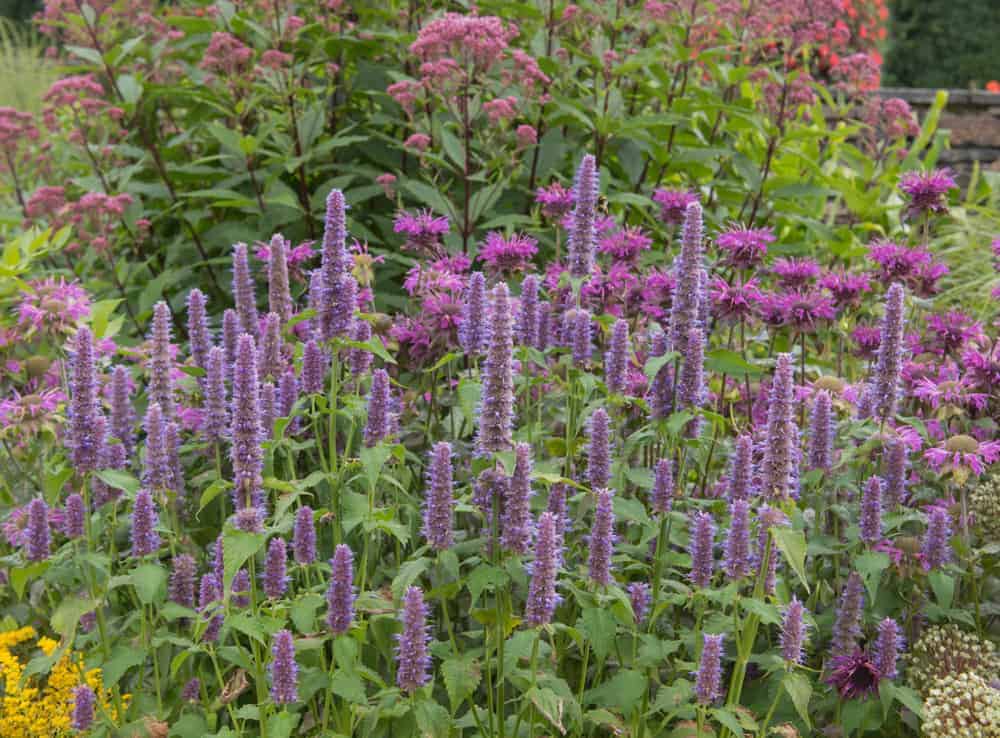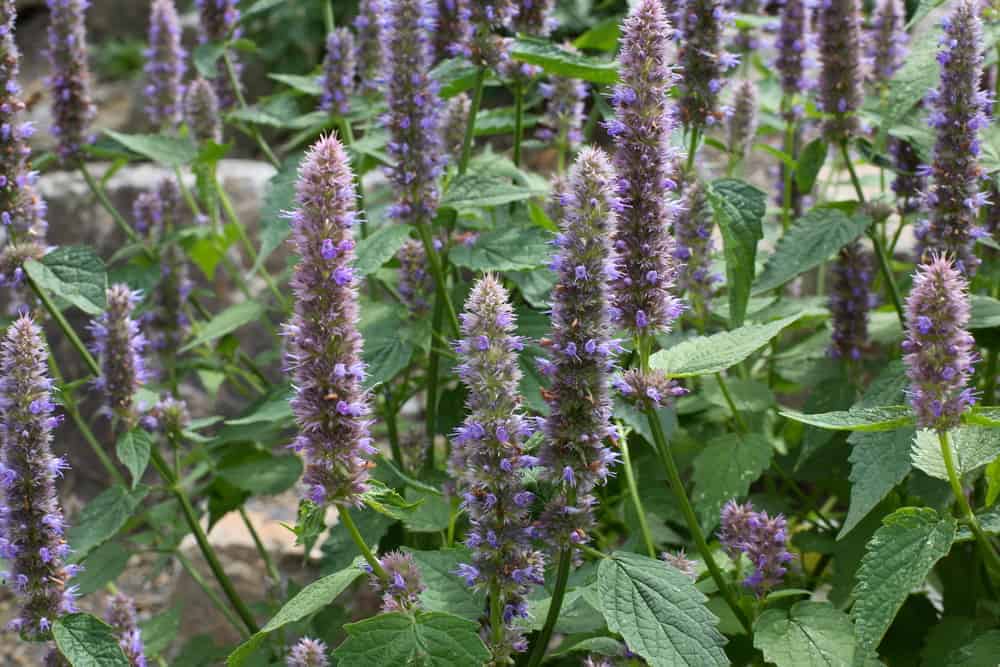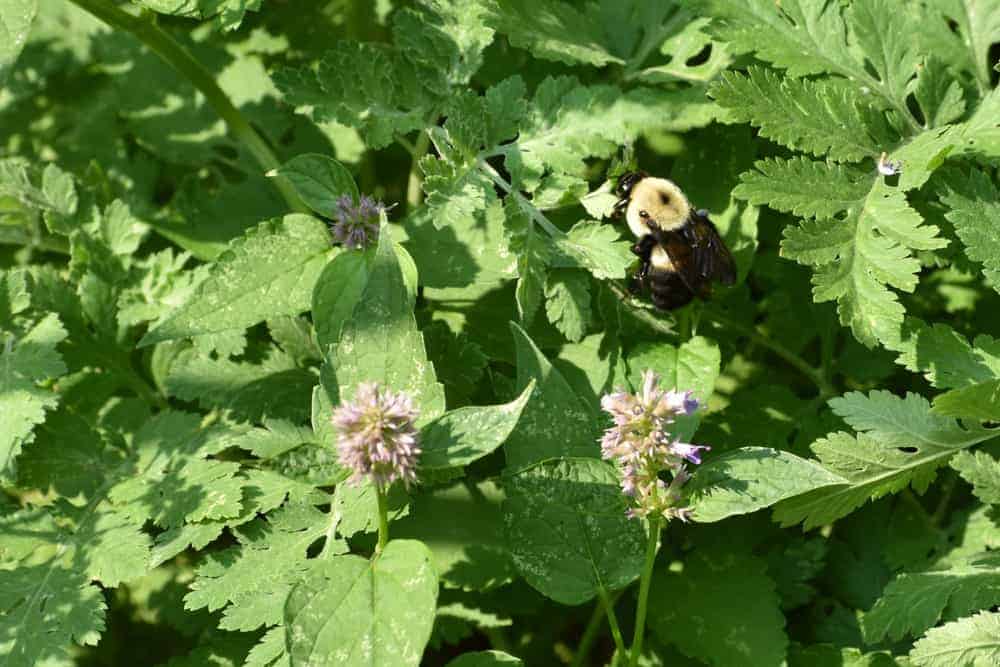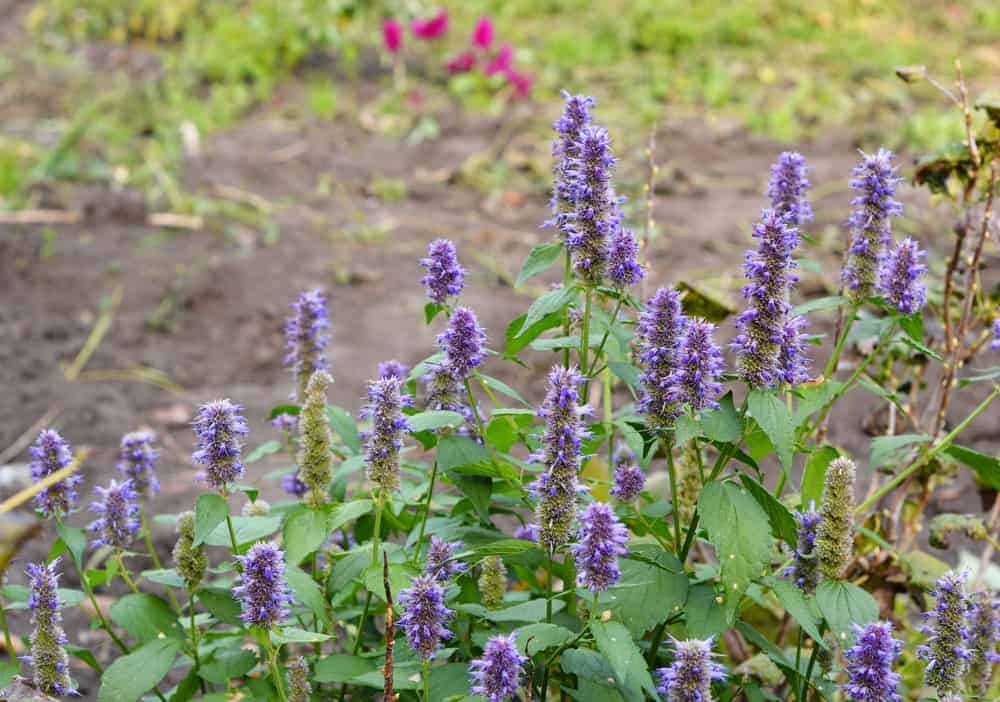Despite its name, Anise hyssop (Lavender giant hyssop, blue giant hyssop, licorice plant, fragrant giant hyssop) is neither anise nor hyssop. It is actually a member of the mint family originating in the Midwest and Canada. You can plant it along borders, or as a part of a unique herb garden or wildflower garden.
This beautiful plant, which was declared the official herb of 2019, attracts honeybees, butterflies, and birds with the combination of mint, licorice, and anise fragrance. Its 4 to 6 inches (10 – 15 cm) long spikes of two-lipped blooms remind me of a cross between a lilac flower, small stems of lavender, and triangular leaves of catnip or mint. I really consider this plant an indispensable part of every butterfly garden.
Why Grow Anise Hyssop

Native Americans used this plant, wide-spread across North America, to reduce fever and suppress cough, sore throat, flu, and cold. Since Anise hyssop has many antibacterial properties, Indians also used it to treat infected wounds and severe burns.
Except that these vivid purple, white, pink, or blue flowers on 24 to 48 inches (61 cm – 1.2 m) tall stems can be a remedy for a few ailments, you can also eat them fresh. They are delicious as a salad or a material for making herbal tea or flavor jelly.
When harvested immediately after passing the full bloom, leaves contain the highest amount of oil. If you want to use dried leaves as an amazing part of potpourri, you can collect them at any time.
The Most Beautiful Varieties of Anise Hyssop
Thanks to its strong fragrance of peppermint, flowers of Anise hyssop are highly attractive to hummingbirds. Also, they are alluring for bees, bumblebees, many beetles, and butterflies feeding on nectar or pollen.
Color of these beautiful blooms may vary from white to pale-blue, but the most popular are types with lavender and blue-purple flowers.
I hope that you will love their showy, lovely spikes of tiny florets as much as I do. They are surrounded by rich, sharply-toothed, oval or pointed, 3 inches (7.6 cm) long green leaves with a quilted surface.
I will list here some of my favorite and most attractive varieties you can include in your garden.
The most popular varieties of Anise hyssop |
||
|
Variety |
Flowers | Height |
| Purple Giant-Hyssop | Purple |
36 to 48 inches (91 cm – 1.2 m) |
|
Blue Fortune (sterile hybrid) |
Lavender-blue | 36 to 48 inches (91 cm – 1.2 m) |
| Alba Anise-hyssop | Creamy white |
36 to 48 inches (91 cm – 1.2 m) |
|
Blue Blazes (hybrid) |
Lavender-purple | 36 to 48 inches (91 cm – 1.2 m) |
| Alabaster | Creamy-white |
36 inches (91 cm) |
|
Nettleleaf Giant-Hyssop |
Rose-pink | 36 inches (91 cm) |
| Snow Spike | White flowers |
36 inches (91 cm) |
|
Heatwave hyssop (hybrid) |
Magenta-pink | 24 to 36 inches (61 – 91 cm) |
| Black Adder (hybrid) | Smoky red-violet |
24 to 36 inches (61 – 91 cm) |
|
Red Fortune (hybrid) |
Pink or red | 24 to 28 inches (61 – 71 cm) |
| New Mexico Giant-Hyssop | Rose-pink |
18 to 24 inches (46 – 61 cm) |
|
Apache Sunset Giant-Hyssop |
Salmon or orange | 18 to 24 inches (46 – 61 cm) |
| Golden Jubilee | Lavender-blue |
12 to 36 inches (31 – 91 cm) |
How to Plant Anise Hyssop in Your Garden

Propagation by seeds
Anise hyssop is a self-sowing plant. However, you can purchase and sow its seeds when deciding to grow this unique flower for the first time.
- Planting Anise hyssop indoors
Even though starting this flower outdoors is quite easy, you can sow it indoors in winter as well. Try to begin approximately two months before the last frost in spring. You will need 6 inches (15 cm) wide pot deep enough for this purpose.
Spread seeds 0.25 to 0.5 inches (6 mm – 1.3 cm) deep and put the pot on the sunny windowsill. Provide the temperatures of about 70 F (21 C) for your plant and wait patiently for 7 to 30 days for seeds to germinate. You should transplant seedlings in your garden when the risk of severe frost passes.
- Planting Anise hyssop outdoors
When you decide to sow seeds directly in your garden, do it at least a week before the last frost in spring. Provide the fertile, well-drained, and consistently moist soil for your future plant.
Since seeds are tiny, scatter them just about 0.25 inches (6 mm) deep into the ground. There is also a possibility to sow seeds outdoors in autumn. In that case, they will be dormant during winter and sprout in early spring after the last frost.
Propagation by cuttings
Starting this plant from cuttings is not too complicated. The best time to cut young shoots is in spring or summer when they are at least 8 inches (20 cm) tall.
Dip their tips in rooting hormone to encourage rooting, and plant shoots in the pots filled with potting soil. Expect the occurrence of roots in three weeks, when you can transplant new plants in your garden.
Propagation by division
Anise hyssop uses its clumps for spreading. That means that you can divide these clumps every three to five years to start new plants and reinvigorate their healthy growth. The best choice is using the younger plant, which hasn’t had enough time to develop too long taproots.
Use a garden shovel to dig up the flower in spring or autumn. Choose healthy clumps of medium size and transplant them right away. Water abundantly while new seedlings establish.
How to Care Anise Hyssop in Your Garden

Space
When you decide to grow Anise Hyssop in your garden, you should space them at least 6 and 12 inches (15 – 30.5 cm) apart.
Soil
Anise hyssop is a highly tolerant plant when it comes to the quality of the soil, and it can flourish even when planted in the clay-rich one. However, it will grow best in the well-drained, compost-rich, and sandy ground.
The range of pH this plant can tolerate varies from 5.0 to 8.0, but an ideal range for the healthy and vigorous growth is from 6.5 to 7.0.
Light
Before you start planting Anise hyssop, you need to determine the right place for it. This plant requires full sun to flourish, but it can tolerate light shade as well. In fact, some shadow during afternoons can be beneficial for this flower.
On the other hand, you should provide a standard fluorescent lamp for a plant growing indoors. The best solution is to place the lamp 2 to 4 inches (5 – 10 cm) above the top of your flower.
Temperatures
Anise Hyssop is not the frost-tolerant plant, and it can thrive outdoors only when the temperatures are high enough. On the other hand, if you live in the region without freezing winters, you can expect your flower returns the following spring from roots.
Interestingly, seeds of this plant require temperatures of at least 60 to 75 F (15.5 – 24 C) for two weeks after sowing. After that, you should provide lower temperatures of 33 to 35 F (0.5 – 1.7 C) for a month or more if you want them to germinate correctly. Only that way, you will get healthy sprouts.
Watering
For abundant flowering, your Anise hyssop requires regular watering and continuously moist soil. Since it originates in lakeshores, you can’t expect your flower to be resistant to drought. When the plant doesn’t get enough water, you will see dropping their leaves and consequent wilting of the whole plant.
Fertilizing
In general, Anise hyssop needs light fertilizing. Add some compost at any time during the season of growing, and it will thrive.
Mulching
You should expect your lovely flower dies back in winter. However, it will re-emerge in spring. To save your Anise hyssop from coldness and help it overwinters, you should cover it with a thick layer of mulch.
Supporting
Once maturing, your plant will probably require staking to stay upright, especially if you live in the windy region.
Pruning
Anise hyssop has a long blooming season, and you should deadhead wilted flowers to encourage continuous flourishing. Also, you can cut spikes to make fresh bouquets, use them for making salads, or to dry them for floral arrangements.
I can recommend you to prune your plant because it is the best way to encourage a beautiful bushy shape during the whole season of growing. Cut woody parts of stems in spring and stems and wilted leaves in autumn. Pruning material after the first frost will make the new growth in spring easier and more delightful.
Anise Hyssop Harvesting
Use garden snip and collect leaves of your Anise hyssop before flower buds start opening. The reason is that the foliage has the best flavor just before the plants blooming. Cut leaves from the bottom of your flower early in the morning.
There is also a possibility to pinch off the bottom leaves during the whole season, but you need to be careful not to overharvest.
If you collect your plant for tea, you will need to cut the whole stems approximately 4 to 5 inches (10 – 13 cm) from the base. After that, you can strip all the foliage away. If you need flowers, the best option is to harvest them when they are open at least three-quarters.
Drinking this tea is highly beneficial to the health of the heart, but you can use it to reduce fevers and alleviate coughs and cold. Moreover, you can use the seeds as a flavoring substitute.
How to Store Anise Hyssop
Leaves
The best way to store the foliage of your Anise hyssop is to hang bunches upside down and let them air dry. To get the best results, you should dry stems in a well-ventilated and lightly shaded place.
If you prefer drying leaves in a microwave, you can do it as well. Set it on ‘high’ for two to three minutes and often check the level of dryness. You can keep dried foliage for months in an airtight container.
Flowers
Start with cutting stems with flowers in the morning, and then bind bunches together and hang them upside down in a dry, shady place. Don’t forget to place the old newspaper beneath the flowers to collect seeds.
Dry your flowers up to one month, pick up bunches, and shake them gently to remove remaining seeds. Arrange flowers depending on your wishes and use seeds to feed birds.
Anise Hyssop Pests and Diseases

Anise hyssop has no significant problems with pests and diseases because its scent repels most insects.
- Root rot – When you grow this plant in the wet or poorly drained soil, you can expect to face this issue. When root starts rotting, your Anise hyssop will become yellow, wilted, and it will probably die eventually.
- Powdery mildew – You can expect the development of these fungi when the year is too humid. Remove infected plants as soon as the infection appears to prevent its spreading.
- Snails and slugs – These creatures feed on seedlings, especially when the season is wet.
- Rabbits – Deer usually avoid the licorice fragrance of Anise hyssop. On the other hand, rabbits like eating the foliage of this plant. They can ruin flowers and entirely devastate the appearance of your garden.

i live with one of my sons which makes it handy for me i am kinda old and use that whenever i feel i can get away with it ihave about 6 ac. used to be in alfalfa and i have access to irragation i started small with hyssop plants and catnip plants for we have a couple hives of bees wanted to see which the bees would perfer they realy like them both i tried several flowers and narrowed it down to hyssop and catnip they seem to faver hyssop but i will keep them both for both are drought tolerant and i dont realy have to babysit them i do water them though i will probly expand the size to have probly a couple ac. of hyssop love the fragrance when i inspect the garden
i apericate all the info we grow hyssop for the honey and the leaves for tea it seems our bees love it along with several differant looking bumble bees they are kinda small once in a while i notice a large one they create no problems i will just plant more to keep all happy except for some small canary looking birds i try and shoo them away but they sort of ignore me and fly to a different plant just a few feet from me i think they are after the seeds for the birds are rather small which makes it easy for them to spot the seeds out of all the birds they are the only ones that go after the hyssop plant